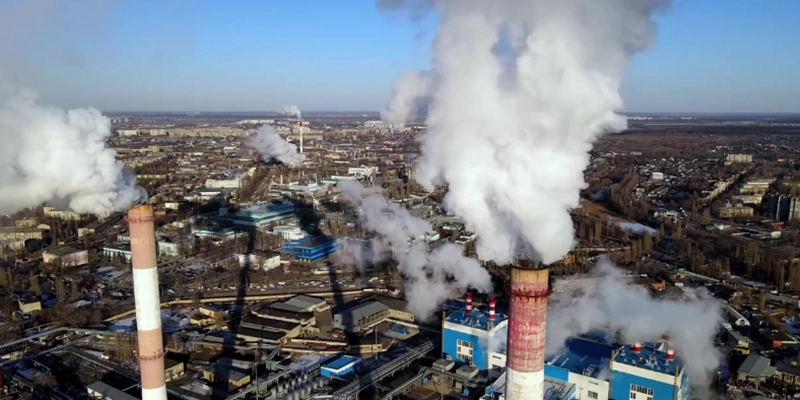The Paula M. Trienens Institute R&D Pillars
With a shared goal of decarbonization, the Trienens Institute R&D Pillars leverage Northwestern strengths to accelerate the transition to a clean energy future
Creating technologies and processes to remove carbon dioxide from industrial emissions and the air

At the beginning of the Industrial Revolution, the amount of carbon dioxide in the atmosphere was about 280 parts per million (ppm). Today, that number has increased to more than 400 ppm.
Rapidly growing amounts of greenhouse gases (including carbon dioxide) in the atmosphere fuel today’s climate crisis—impacting vulnerable communities around the world. And while countries work to adopt clean energy sources like wind and solar to reduce future emissions, scientists and engineers are also tackling the problem from a different angle: removing carbon dioxide from industrial emissions before it reaches the atmosphere.
This decarbonization involves capturing carbon dioxide (CO2) right at the polluting source — like at factories in the steel and cement industries — but also from the air itself. But capturing carbon dioxide from dilute sources such as the air, and later sequestering it constitutes a major engineering challenge.
“It’s like trying to find a needle in a haystack,” said Omar Farha, Charles E. and Emma H. Morrison Professor and Chair of Chemistry. “We want to remove the carbon dioxide from the air, but air is full of water and other gasses that you don’t want to take away. Creating a material that can fish carbon dioxide out of that sea is very complicated.”
Northwestern scientists and engineers are up to the challenge. The pillar is one of the Paula M. Trienens Institute for Sustainability and Energy’s R&D Pillars, which are aimed at leading interdisciplinary research in decarbonization. As part of the Trienens Institute’s Capture pillar, Northwestern is leading the development and testing of porous materials and other new methods of capturing carbon.
“What makes Northwestern really special is that we have people from engineering, science, and even social science and economics who come together in teams,” said Randall Snurr, John G. Searle Professor of Chemical and Biological Engineering who co-leads the pillar with Farha. “That intellectual diversity is essential for solving a problem like this.”
There are pilot projects around the world aiming to capture CO2 from the air, but so far, no project has done so at a large enough scale to make a difference.
Northwestern’s efforts include the new Midwest Nuclear DAC Hub (MINDAC), for which Farha is a co-principal investigator. Funded by the U.S. Department of Energy and administered through the Trienens Institute, MINDAC will test the feasibility of using a zero-emission nuclear fleet to power air handling units that remove carbon dioxide from the atmosphere. As the leader of MINDAC, Northwestern has partnered with a host of industrial partners and Argonne National Laboratory to develop a model to integrate carbon capture technologies with CO2 transportation and sequestration.
The Hub builds on major carbon capture research already happening at Northwestern. For years, Farha and Snurr have worked to develop materials that can capture carbon from the air or more concentrated sources of CO2. Their metal-organic frameworks — highly structured, porous nanomaterials — can act as sponges that soak up CO2 while leaving water in the air.
“We show that this material can survive in harsh conditions, which is necessary for a material like this,” Farha said. Their startup company is currently exploring how to scale the material.
Other faculty are taking different approaches to capturing CO2. Vinayak Dravid, Abraham Harris Professor of Materials Science and Engineering, published research with Farha last year that looked at the relationship between water and carbon dioxide to better capture CO2. They expanded the array of ions that can be used in the capture process and worked to better understand the “moisture-swing” technique, which captures CO2 at low humidities and release it at high humidities.
Faculty are also working on novel ways to capture and store carbon that exploit naturally occurring processes. Andrew Jacobson, professor and director of graduate studies in the Department of Earth and Planetary Sciences, is studying how CO2 can be captured and stored by accelerating the chemical weathering of rocks. The decarbonization technology has been dubbed Enhanced Weathering.
When CO2 dissolves in water, it becomes carbonic acid, which dissolves rocks and minerals. This process transforms CO2 to HCO3-, which is stable in solution for ~104-106 years and thus serves as a carbon sink on human timescales. Jacobson is currently leading a team of researchers at Northwestern and the Chicago Botanic Garden to test adding crushed basalt to soils typically employed in agricultural settings. Earth Scientists have long hypothesized that basalt dissolves faster than other rock types, such as granite. Enhanced Weathering has additional benefits, including controlling soil pH, releasing nutrients for plant growth, and providing a new revenue stream for farmers.
Other faculty working on carbon capture include Trienens Institute Executive Director Ted Sargent and faculty Dayne Swearer, Jeff Richards, Joe Hupp, and Christian Malapit.
“We are all thinking about creating new materials and reducing the energy cost for capturing CO2,” Snurr said.
“We are not continuing to work on the same old things,” Snurr said. “New grants are helping faculty try new ideas, and we want to harness that to acquire additional funding support from government agencies and industry.”
Research under the pillar is designed to test early ideas and secure funding for continued work on the ones that are most promising. Partnerships with industry will be essential to make new technologies a reality.
“Any place that uses electricity could benefit from carbon capture,” Farha said. “Every industry has something to gain from it. Right now, there are questions of who would bear the cost, but we know that the benefits would be broad.”
Ultimately, scientists and engineers need to find a way to pull billions of tons of CO2 from the atmosphere to help mitigate the effects of climate change.